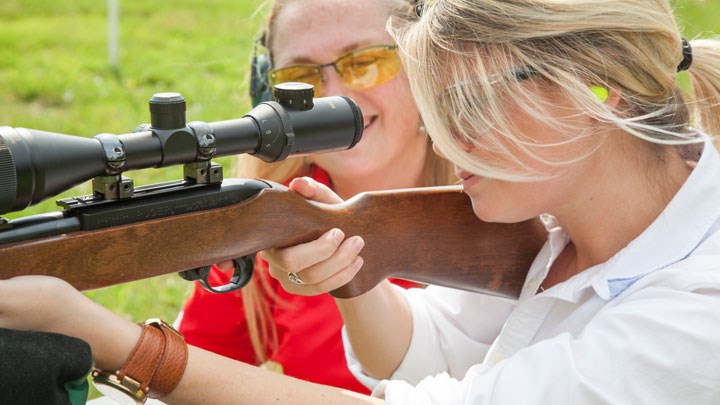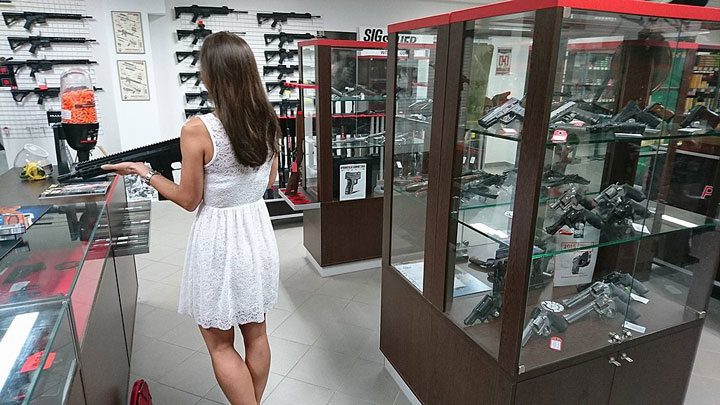
by Amy Ray, President and CEO, The Sisterhood of the Outdoors - Friday, March 3, 2023

When it comes to new hunters, one of the questions that I answer the most often at The Sisterhood of the Outdoors is, “Which rifle should I choose?” I am sharing my thoughts and experience when it comes to helping new hunters purchase their first rifles and how I mentor them.
To help someone choose a first rifle, you must first understand the purpose. This is true with all first firearm purchases. The purpose can define the equipment needed very quickly. Because I lead women’s hunting events, I always prepare my hunters for the equipment necessary to succeed in the field. For simplicity purposes, I will share how I help new big-game hunters select the proper bolt-action rifles for their adventures.
1. Eye Dominance
Always start with eye dominance. Cross-dominant rifle shooters may want to try left- or right-handed bolts, depending on which side they mount their scopes. While left-handed bolt-action rifles are available, they are only sometimes on the shelves at sporting goods stores. They can be ordered. I have seen many left-handed shooters adapt to right-handed bolt-action rifles.
2. Caliber Required
If a new hunter asks about selecting a rifle for big game, it almost always starts with caliber. While this is a perfect place to start, other selection parameters are needed. Choosing a caliber can be animal specific. And if you ask on social media about caliber choices, you will get plenty of answers. The correct answer is in the details of the type of rifle you plan to purchase. I see many women lean into caliber as the answer to low recoil. And while this is true, one can also reduce recoil with larger-caliber rifles.
I recommend .243 and .308 for youth and new shooters for whitetail, coyote and hogs. If they planned an elk hunt as their first hunt, I recommend .270, .30-06, .300 Winchester Magnum and 7mm Remington Magnum. The most important point is that caliber is not the first and only attribute to finding a great rifle.
3. Budget
The third most important facet is the budget. My first rifle was a combo rifle with a scope for around $500. It turned out to be the rifle I shot my first deer with, but it was also the worst choice for me. The gun was a .30-06, and it kicked hard. I was new to shooting, and I flinched equally as hard. I downsized the caliber to a .243 rifle with a smaller stock and higher cheek piece and became very successful. I teach new shooters with my .243 to start them out without fear of recoil. When it is fun to shoot, they will shoot more. The more they shoot, the more they will build their confidence. This makes introducing them to larger caliber rifles easier and helps them build proper shooting skills. This can also be done by taking new shooters to the range with a .22 caliber rifle to start.
Once eye dominance, budget and caliber are established, I can begin to understand the level of skills a new hunter has acquired. This is the best time to encourage more range time with a partner and a shared firearm. I love the idea of try-before-you-buy. This is also a great time to determine if someone has a shorter length of pull and has trouble acquiring a target in a scope.
4. Rifle Fit
One of the most critical pieces of the puzzle is the rifle fit. The length of pull and the eye relief of the scope are shooter specific. I have coached women with shorter arms using my rifles or rifles at the range and have seen firsthand how hard it is for them to gain the proper sight picture in the scope. They simply don’t fit the guns. I always recommend trying rifles with adjustable stocks or higher cheek pieces. I recommend shouldering the rifles at the gun store and seeing if your cheek hits the stock with your neck straight and eyes aligned to the scope. Check to see if you can place the rifle on the shoulder (in the pocket) and still pull the trigger with the first tap of your finger and see through the scope. Adjust the scope to zoom out at first, then zoom all the way in and determine if you can acquire a sight picture.

5. More on Shooting Expectations
After establishing eye dominance, budget, caliber and rifle fit, I always ask what type of shooting interests them. Target practice at the range is much different than a hunting scenario. For example, I rarely off-hand any of my shots. I like to have a shooting stick for spot-and-stalk hunting. And I use a shooting house window or rail when possible. New hunters may need to be made aware of these accessory options. And if you are teaching them to shoot from a window of a shooting house or shooting rail on a stand, inform them that the barrel should never be placed on the rail and always place only the stock on the base when taking a shot.
6. So Many Choices
Some ways to reduce recoil with larger caliber rifles include using a heavier-weight gun with a lighter trigger pull and a muzzle brake. New hunters need to know that they can request that the trigger pull on each model be adjusted and that they can purchase aftermarket triggers to help with this task. Read the owner’s manual to see the manufacturer's trigger-pull setting and whether it is adjustable or check the trigger pull using a special gizmo to do so. A lighter trigger pull can reduce recoil and help with flinching on the shot. Here’s where professional gunsmiths can come in handy. I have had success teaching new hunters to use a long-range .308 caliber rifle with a muzzle brake and lighter trigger.
7. Scope Selection
I recommend spending as much as your budget will allow for a scope. Having good optics helps to ensure a successful hunt. The most critical aspect of choosing a scope is knowing the distance you plan to shoot. We rarely take shots past 150 to 200 yards here in the South for whitetail deer. But for big game out West, success rates go up if your scope can help you consistently reach out as far as 500 yards. Today’s market for optics is wide open. A basic scope will do the job for under $300, or you can spend more than $1,000 for longer-range scopes.
8. Eye Relief
Proper eye relief is one of the most important factors for setting up success. A local gun store or gunsmith can help mount the scope and adjust it to fit as needed. We use a lot of partner rifles at our events, and it is quickly noticeable if one of our new hunters is struggling to find the target in the scope. When a hunter struggles with finding a target in the scope, I dial down the zoom and have them lean all the way into the scope and slowly move their head backward until the sight picture is fully visible.
I have helped many women set up their first rifle, and I love seeing them enjoy time in the field. I am amazed at how the technology of rifles and scopes has made it easier for first-time shooters to succeed. I helped a new elk hunter last year with a long-range .300 Win. Mag. and a scope setup for ballistic dialing out to 1,000 yards. She consistently rang steel at 200, 300 and 600. We adjusted her scope to her eye relief, and she had an adjustable cheekpiece we raised to align her eye straight through the scope, so she felt ready and confident to hunt. I was fortunate to be with her when she shot her first elk with the new rifle.
Although social media is a great place to start to ask questions about purchasing a new rifle—especially if you want to see thousands of responses and decide on laws of average for which is most popular—it is not always the best idea. I recommend that new shooters and hunters find mentors. As a mentor, I can send a private message that I am available to help them make the right choices. Throughout the years of surveying new hunters, I have found that most start with shooting someone else’s rifle. Along with that rifle comes mentorship from the owner. New shooters tend to buy what a friend or family member recommends or likes. And they almost always purchase a first rifle, which is never their last.
E-mail your comments/questions about this site to:
[email protected]
Proudly supported by The NRA Foundation and Friends of NRA fundraising.
